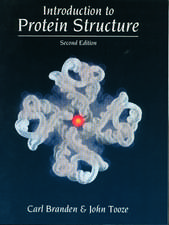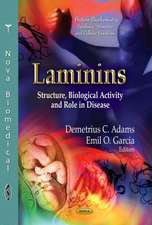Clinical Proteomics: Methods and Protocols: Methods in Molecular Biology, cartea 428
Editat de Antonia Vlahouen Limba Engleză Paperback – 19 noi 2010
| Toate formatele și edițiile | Preț | Express |
|---|---|---|
| Paperback (1) | 890.68 lei 6-8 săpt. | |
| Humana Press Inc. – 19 noi 2010 | 890.68 lei 6-8 săpt. | |
| Hardback (1) | 650.69 lei 6-8 săpt. | |
| Humana Press Inc. – 18 ian 2008 | 650.69 lei 6-8 săpt. |
Din seria Methods in Molecular Biology
- 9%
 Preț: 791.59 lei
Preț: 791.59 lei - 23%
 Preț: 598.56 lei
Preț: 598.56 lei - 20%
 Preț: 882.95 lei
Preț: 882.95 lei -
 Preț: 252.04 lei
Preț: 252.04 lei - 5%
 Preț: 802.69 lei
Preț: 802.69 lei - 5%
 Preț: 729.61 lei
Preț: 729.61 lei - 5%
 Preț: 731.43 lei
Preț: 731.43 lei - 5%
 Preț: 741.30 lei
Preț: 741.30 lei - 5%
 Preț: 747.16 lei
Preț: 747.16 lei - 15%
 Preț: 663.45 lei
Preț: 663.45 lei - 18%
 Preț: 1025.34 lei
Preț: 1025.34 lei - 5%
 Preț: 734.57 lei
Preț: 734.57 lei - 18%
 Preț: 914.20 lei
Preț: 914.20 lei - 15%
 Preț: 664.61 lei
Preț: 664.61 lei - 15%
 Preț: 654.12 lei
Preț: 654.12 lei - 18%
 Preț: 1414.74 lei
Preț: 1414.74 lei - 5%
 Preț: 742.60 lei
Preț: 742.60 lei - 20%
 Preț: 821.63 lei
Preț: 821.63 lei - 18%
 Preț: 972.30 lei
Preț: 972.30 lei - 15%
 Preț: 660.49 lei
Preț: 660.49 lei - 5%
 Preț: 738.41 lei
Preț: 738.41 lei - 18%
 Preț: 984.92 lei
Preț: 984.92 lei - 5%
 Preț: 733.29 lei
Preț: 733.29 lei -
 Preț: 392.58 lei
Preț: 392.58 lei - 5%
 Preț: 746.26 lei
Preț: 746.26 lei - 18%
 Preț: 962.66 lei
Preț: 962.66 lei - 23%
 Preț: 860.21 lei
Preț: 860.21 lei - 15%
 Preț: 652.64 lei
Preț: 652.64 lei - 5%
 Preț: 1055.50 lei
Preț: 1055.50 lei - 23%
 Preț: 883.85 lei
Preț: 883.85 lei - 19%
 Preț: 491.88 lei
Preț: 491.88 lei - 5%
 Preț: 1038.84 lei
Preț: 1038.84 lei - 5%
 Preț: 524.15 lei
Preț: 524.15 lei - 18%
 Preț: 2122.34 lei
Preț: 2122.34 lei - 5%
 Preț: 1299.23 lei
Preț: 1299.23 lei - 5%
 Preț: 1339.10 lei
Preț: 1339.10 lei - 18%
 Preț: 1390.26 lei
Preț: 1390.26 lei - 18%
 Preț: 1395.63 lei
Preț: 1395.63 lei - 18%
 Preț: 1129.65 lei
Preț: 1129.65 lei - 18%
 Preț: 1408.26 lei
Preț: 1408.26 lei - 18%
 Preț: 1124.92 lei
Preț: 1124.92 lei - 18%
 Preț: 966.27 lei
Preț: 966.27 lei - 5%
 Preț: 1299.99 lei
Preț: 1299.99 lei - 5%
 Preț: 1108.51 lei
Preț: 1108.51 lei - 5%
 Preț: 983.72 lei
Preț: 983.72 lei - 5%
 Preț: 728.16 lei
Preț: 728.16 lei - 18%
 Preț: 1118.62 lei
Preț: 1118.62 lei - 18%
 Preț: 955.25 lei
Preț: 955.25 lei - 5%
 Preț: 1035.60 lei
Preț: 1035.60 lei - 18%
 Preț: 1400.35 lei
Preț: 1400.35 lei
Preț: 890.68 lei
Preț vechi: 1086.19 lei
-18% Nou
Puncte Express: 1336
Preț estimativ în valută:
170.43€ • 178.42$ • 141.02£
170.43€ • 178.42$ • 141.02£
Carte tipărită la comandă
Livrare economică 07-21 aprilie
Preluare comenzi: 021 569.72.76
Specificații
ISBN-13: 9781617377990
ISBN-10: 1617377996
Pagini: 408
Ilustrații: XVI, 408 p. 74 illus.
Dimensiuni: 155 x 235 x 22 mm
Greutate: 0.59 kg
Ediția:Softcover reprint of hardcover 1st ed. 2008
Editura: Humana Press Inc.
Colecția Humana
Seria Methods in Molecular Biology
Locul publicării:Totowa, NJ, United States
ISBN-10: 1617377996
Pagini: 408
Ilustrații: XVI, 408 p. 74 illus.
Dimensiuni: 155 x 235 x 22 mm
Greutate: 0.59 kg
Ediția:Softcover reprint of hardcover 1st ed. 2008
Editura: Humana Press Inc.
Colecția Humana
Seria Methods in Molecular Biology
Locul publicării:Totowa, NJ, United States
Public țintă
Professional/practitionerCuprins
Preface.- Acknowledgments.- Contributors.- 1. Overview and Introduction to Clinical Proteomics Young-Ki Paik, Hoguen Kim, Eun-Young Lee, Min-Seok Kwon, and Sang Yun Cho.- I: Specimen Collection for Clinical Proteomics.- 2. Specimen Collection and Handling: Standardization of Blood Sample CollectionHarald Tammen.- 3. Tissue Sample Collection for Proteomics Analysis Jose I. Diaz, Lisa H. Cazares, and O. John Semmes.- II: Clinical Proteomics by 2DE and Direct MALDI/SELDI MS Profiling.- 4. Protein Profiling of Human Plasma Samples by Two-Dimensional Electrophoresis Sang Yun Cho, Eun-Young Lee, Hye-Young Kim, Min-Jung Kang, Hyoung-Joo Lee, Hoguen Kim, and Young-Ki Paik.- 5. Analysis of Laser Capture Microdissected Cells by 2-Dimensional Gel Electrophoresis Daohai Zhang and Evelyn Siew-Chuan Koay.- 6. Optimizing the Difference Gel Electrophoresis (DIGE) Technology David B. Friedman and Kathryn S. Lilley.- 7. MALDI/SELDI Protein Profiling of Serum for the Identification of Cancer Biomarkers Lisa H. Cazares, Jose I. Diaz, Rick R. Drake, and O. John Semmes.- 8. Urine Sample Preparation and Protein Profiling by Two-Dimensional Electrophoresis and Matrix-Assisted Laser Desorption Ionization Time of Flight Mass Spectroscopy Panagiotis G. Zerefos and Antonia Vlahou.- 9. Combining Laser Capture Microdissection and Proteomics Techniques Dana Mustafa, Johan M. Kros, and Theo Luider.- III: Clinical Proteomics by LC-MS Approaches.- 10. Comparison of Protein Expression by Isotope-Coded Affinity Tag Labeling Zhen Xiao and Timothy D. Veenstra.- 11. Analysis of Microdissected Cells by Two-Dimensional LC-MS Approaches Chen Li, Yi-Hong, Ye-Xiong Tan, Jian-Hua Ai, Hu Zhou, Su-Jun Li, Lei Zhang, Qi-Chang Xia, Jia-Rui Wu, Hong-Yang Wang, and Rong Zeng.- 12. Label-Free LC-MS Method for the Identification of Biomarkers Richard E. Higgs, Michael D. Knierman, Valentina Gelfanova, Jon P. Butler, and John E. Hale.- 13. Analysis of the Extracellular Matrix and Secreted Vesicle Proteomes by Mass Spectrometry Zhen Xiao, Thomas P. Conrads, George R. Beck, Jr., and Timothy D. Veenstra.- IV: Clinical Proteomics and Antibody Arrays.- 14. Miniaturized Parallelized Sandwich Immunoassays Hsin-Yun Hsu, Silke Wittemann, and Thomas O. Joos.- 15. Dissecting Cancer Serum Protein Profiles Using Antibody Arrays Marta Sanchez-Carbayo.- V: Statistics and Bioinformatics in Clinical Proteomics Data Analysis.- 16. 2D-PAGE Maps Analysis Emilio Marengo, Elisa Robotti, and Marco Bobba.- 17. Finding the Significant Markers: Statistical Analysis of Proteomic DataSebastien Christian Carpentier, Bart Panis, Rony Swennen, and Jeroen Lammertyn.- 18. Web-Based Tools for Protein Classification Costas D. Paliakasis, Ioannis Michalopoulos, and Sophia Kossida.- 19. Open-Source Platform for the Analysis of Liquid Chromatography-Mass Spectrometry (LC-MS) Data Matthew Fitzgibbon, Wendy Law, Damon May, Andrea Detter, and Martin McIntosh.- 20. Pattern Recognition Approaches for Classifying Proteomic Mass Spectra of Biofluids Ray L. Somorjai.
Recenzii
From the reviews:
"Clinical proteomics is a fledgling field that is struggling to define its standards and whose underlying technologies continue to evolve at a very rapid pace. ... This multiauthored book provides state-of-the-art information and practical protocols on these topics and many other related areas. ... provides a wealth of background information and underlying principles. ... Overall, this is an excellent book whose natural readership includes both newcomers to the field and seasoned biomarker hunters who wish to update their knowledge or explore new techniques." (Marco Crescenzi, Annali dell'Istituto Superiore di Sanita, Vol. 44 (3), November, 2008)
"Clinical proteomics is a fledgling field that is struggling to define its standards and whose underlying technologies continue to evolve at a very rapid pace. ... This multiauthored book provides state-of-the-art information and practical protocols on these topics and many other related areas. ... provides a wealth of background information and underlying principles. ... Overall, this is an excellent book whose natural readership includes both newcomers to the field and seasoned biomarker hunters who wish to update their knowledge or explore new techniques." (Marco Crescenzi, Annali dell'Istituto Superiore di Sanita, Vol. 44 (3), November, 2008)
Textul de pe ultima copertă
The field of clinical proteomics has rapidly evolved during the past few years and is continuously growing as new methodologies and technologies emerge. In Clinical Proteomics, a select group of leading researchers has contributed their state-of-the-art methodologies on protein profiling and identification of disease biomarkers in tissues, microdissected cells and body fluids. Experimental approaches involving the application of two-dimensional electrophoresis, multi-dimensional liquid chromatography, SELDI/MALDI mass spectrometry and protein arrays, as well as the bioinformatic and statistical tools pertinent to the analysis of proteomics data, are thoroughly detailed in these readily reproducible methods and protocols, explained through the step-by-step instructional format of the highly successful Methods in Molecular Biology™ series.
With its multi-disciplinary approach, Clinical Proteomics provides integrated, cutting-edge techniques sure to be invaluable to a wide range of researchers including clinicians, molecular biologists, chemists, bioinformaticians and computational biologists.
With its multi-disciplinary approach, Clinical Proteomics provides integrated, cutting-edge techniques sure to be invaluable to a wide range of researchers including clinicians, molecular biologists, chemists, bioinformaticians and computational biologists.
Caracteristici
Compiled by experts in the field, these protocols demonstrate the widespread use of proteomic techniques used in clinical bench work. Step-by-step instructions that ensure successful results Integrates biochemistry, pathology, analytical technology, bioinformatics, and proteomics.













